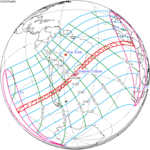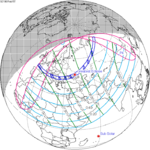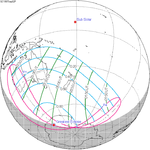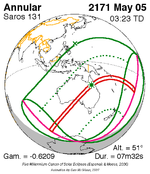Solar eclipse of August 12, 2026
| Solar eclipse of August 12, 2026 | |
|---|---|
| Type of eclipse | |
| Nature | Total |
| Gamma | 0.8977 |
| Magnitude | 1.0386 |
| Maximum eclipse | |
| Duration | 138 s (2 min 18 s) |
| Coordinates | 65°12′N 25°12′W / 65.2°N 25.2°W |
| Max. width of band | 294 km (183 mi) |
| Times (UTC) | |
| Greatest eclipse | 17:47:06 |
| References | |
| Saros | 126 (48 of 72) |
| Catalog # (SE5000) | 9566 |
A total solar eclipse will occur at the Moon's descending node of orbit on Wednesday, August 12, 2026,[1] with a magnitude of 1.0386. A solar eclipse occurs when the Moon passes between Earth and the Sun, thereby totally or partly obscuring the image of the Sun for a viewer on Earth. A total solar eclipse occurs when the Moon's apparent diameter is larger than the Sun's, blocking all direct sunlight, turning day into darkness. Totality occurs in a narrow path across Earth's surface, with the partial solar eclipse visible over a surrounding region thousands of kilometres wide. Occurring about 2.2 days after perigee (on August 10, 2026, at 12:15 UTC), the Moon's apparent diameter will be larger.[2]
The total eclipse will pass over the Arctic, Greenland, Iceland, Atlantic Ocean, northern Spain and very extreme northeastern Portugal.[3] The points of greatest duration and greatest eclipse will be just 45 km (28 mi) off the western coast of Iceland by 65°10.3' N and 25°12.3' W, where the totality will last 2m 18.21s. A partial eclipse will cover more than 90% of the Sun in Ireland, Great Britain, Portugal, France, Italy, the Balkans and North Africa and to a lesser extent in most of Europe, West Africa and northern North America.
The total eclipse will pass over northern Spain from the Atlantic coast to the Mediterranean coast as well as the Balearic Islands. The total eclipse will be visible from the cities of A Coruña, Valencia, Zaragoza, Palma and Bilbao, but both Madrid and Barcelona will be just outside the path of totality.[4]
The last total solar eclipse in continental Europe occurred on August 11, 1999.[5] It will be the first total solar eclipse visible in Iceland since June 30, 1954, also Solar Saros series 126 (descending node), and the only one to occur in the 21st century as the next one visible over Iceland will be in 2196. The last total solar eclipse in Spain happened on August 30, 1905 and followed a similar path across the country. The next total eclipse visible in Spain will happen less than a year later on August 2, 2027.[6]
Circumstances
The eclipse path proceeds from North Siberia throughout the Arctic Region, Iceland, eastern Atlantic to Spain and the Mediterranean.
Solar eclipse and the aurora borealis
In the North Russia area where totality will begin at sunrise, the aurora borealis could also be visible up to the beginning of the nautical twilight, depending on the intensity of the auroral activity at that date. If an extremely high intensity geomagnetic storm takes place simultaneously, there might be chances of seeing the aurora simultaneously with the eclipsed Sun. In the east of Taymyr Peninsula (north-east of Krasnoyarsk Krai) the maximum of total phase will occur on August 13 at 0:00 local time during midnight sun.[7]
Solar eclipse below the horizon
Due to the considerable eclipse gamma (more than 0.8), observers where the totally eclipsed Sun is just below the horizon will have the chance to observe the lunar shadow in the high atmosphere, as well as shortened civil twilight and extended nautical twilight. The darkening of the twilight sky could improve the chances of observing the inner Zodiacal light.[8]
Bright planets and stars visible during totality
Far northern Russia will be treated to a dawn eclipse. Mercury and Jupiter will be very low above the rising eclipsed Sun, but Mercury will be showing most of its sunlit side and Jupiter will have its usual brightness. Mars and Saturn will be more advantageously placed in the northeast and southeast respectively. Of the bright asterisms, the Big Dipper will be very high in the north-northwest and the Summer Triangle will be high in the southwest. Aldebaran, Arcturus, Capella and Pollux are other first-magnitude stars which may be seen, although they will be low.
In Iceland the eclipse will be a mid-afternoon event occurring about 4 hours before sunset, it will start in Reykjavik at around 2:04 PM, with the total eclipse occurring at 3:15 PM.[9] Mars may be a challenge to find, because it will be low in the west. Mercury and Jupiter will be well positioned west of the Sun and Venus will be many degrees to its east. Of 1st-magnitude stars from west to east, Capella and Pollux will be at decent elevations west of the Sun; Regulus, Spica (due south), Arcturus, Vega and Deneb are candidates for easy sighting to the Sun's east. Procyon will be about to set, while Altair will be low on the opposite side.
In Spain the eclipse will occur about 1 hour before sunset. Mercury and Jupiter, west of the eclipsed Sun, will therefore be very low below it. Venus will be brilliant well up in the southwest, with Spica to its east. Arcturus will be high in the south, and the Summer Triangle will be well up in the east. Lower in the south, Antares will be minutes away from transit.[10]
Images
Details of the totality in some places or cities
| Country or Territory | Place or City | Start
of |
Start of total eclipse (Local Time) |
End of total eclipse (Local Time) |
Duration of total eclipse |
End of partial eclipse (Local Time) |
Magnitude |
|---|---|---|---|---|---|---|---|
| East of Taymyr Peninsula, Krasnoyarsk Krai | 23:08:43 | 23:59:21 | 00:00:56 (August 13) | 1 min 35s | 00:51:51 (August 13) | 1,031 | |
| Mestersvig | 16:32:41 | 17:32:52 | 17:34:01 | 1 min 09 s | 18:32:25 | 1,038 | |
| Ísafjörður | 16:43:17 | 17:44:07 | 17:45:38 | 1 min 31 s | 18:43:57 | 1,038 | |
| Grundarfjörður | 16:45:14 | 17:46:03 | 17:47:55 | 1 min 52 s | 18:46:03 | 1,038 | |
| Reykjavík | 16:47:11 | 17:48:15 | 17:49:17 | 1 min 02 s | 18:47:38 | 1,038 | |
| Reykjanesbær | 16:47:11 | 17:48:04 | 17:49:43 | 1 min 39 s | 18:47:52 | 1,038 | |
| Gijón | 19:31:02 | 20:26:47 | 20:28:32 | 1 min 45 s | 21:20:45 | 1,034 | |
| Santander | 19:31:19 | 20:26:55 | 20:27:57 | 1 min 02 s | 21:18:17 (Sunset) | 1,034 | |
| Oviedo | 19:31:19 | 20:27:04 | 20:28:52 | 1 min 48 s | 21:21:04 | 1,034 | |
| Bilbao | 19:31:47 | 20:27:22 | 20:27:52 | 30 s | 21:14:15 (Sunset) | 1,034 | |
| A Coruña | 19:30:56 | 20:27:40 | 20:28:56 | 1 min 15 s | 21:21:59 | 1,034 | |
| León | 19:32:43 | 20:28:19 | 20:30:04 | 1 min 44 s | 21:22:06 | 1,034 | |
| Burgos | 19:33:21 | 20:28:24 | 20:30:07 | 1 min 43 s | 21:15:25 (Sunset) | 1,033 | |
| Zaragoza | 19:34:40 | 20:29:01 | 20:30:25 | 1 min 24 s | 21:02:52 (Sunset) | 1,032 | |
| Tarragona | 19:35:33 | 20:29:28 | 20:30:28 | 1 min 00 s | 20:53:18 (Sunset) | 1,032 | |
| Valladolid | 19:34:30 | 20:29:52 | 20:31:19 | 1 min 27 s | 21:18:12 | 1,033 | |
| Aveleda e Rio de Onor | 18:33:47 | 19:30:21 | 19:30:33 | 12 s | 20:23:29 | 1,034 | |
| Palma de Mallorca | 19:38:03 | 20:31:04 | 20:32:40 | 1m 36 s | 20:44:48 (Sunset) | 1,031 | |
| Castellón de La Plana | 19:37:31 | 20:31:19 | 20:32:52 | 1 m 34 s | 20:56:20 (Sunset) | 1,032 | |
| Alcobendas | 19:36:32 | 20:31:57 | 20:32:21 | 24 s | 21:11:42 (Sunset) | 1,033 | |
| Valencia | 19:38:23 | 20:32:27 | 20:33:28 | 1 min 01 s | 20:56:31 (Sunset) | 1,032 | |
| Ibiza | 19:39:14 | 20:32:44 | 20:33:48 | 1 min 04 s | 20:48:28 (Sunset) | 1,031 |
Eclipse details
Shown below are two tables displaying details about this particular solar eclipse. The first table outlines times at which the moon's penumbra or umbra attains the specific parameter, and the second table describes various other parameters pertaining to this eclipse.[11]
| Event | Time (UTC) |
|---|---|
| First Penumbral External Contact | 2026 August 12 at 15:35:23.9 UTC |
| First Umbral External Contact | 2026 August 12 at 16:59:18.1 UTC |
| First Central Line | 2026 August 12 at 17:01:16.5 UTC |
| First Umbral Internal Contact | 2026 August 12 at 17:03:19.0 UTC |
| Equatorial Conjunction | 2026 August 12 at 17:05:01.6 UTC |
| Ecliptic Conjunction | 2026 August 12 at 17:37:53.9 UTC |
| Greatest Duration | 2026 August 12 at 17:45:53.9 UTC |
| Greatest Eclipse | 2026 August 12 at 17:47:05.8 UTC |
| Last Umbral Internal Contact | 2026 August 12 at 18:31:21.6 UTC |
| Last Central Line | 2026 August 12 at 18:33:21.7 UTC |
| Last Umbral External Contact | 2026 August 12 at 18:35:17.7 UTC |
| Last Penumbral External Contact | 2026 August 12 at 19:59:09.2 UTC |
| Parameter | Value |
|---|---|
| Eclipse Magnitude | 1.03863 |
| Eclipse Obscuration | 1.07876 |
| Gamma | 0.89774 |
| Sun Right Ascension | 09h29m47.3s |
| Sun Declination | +14°48'04.5" |
| Sun Semi-Diameter | 15'47.0" |
| Sun Equatorial Horizontal Parallax | 08.7" |
| Moon Right Ascension | 09h31m17.3s |
| Moon Declination | +15°36'58.5" |
| Moon Semi-Diameter | 16'16.9" |
| Moon Equatorial Horizontal Parallax | 0°59'45.1" |
| ΔT | 72.4 s |
Eclipse season
This eclipse is part of an eclipse season, a period, roughly every six months, when eclipses occur. Only two (or occasionally three) eclipse seasons occur each year, and each season lasts about 35 days and repeats just short of six months (173 days) later; thus two full eclipse seasons always occur each year. Either two or three eclipses happen each eclipse season. In the sequence below, each eclipse is separated by a fortnight.
| August 12 Descending node (new moon) |
August 28 Ascending node (full moon) |
|---|---|
 |

|
| Total solar eclipse Solar Saros 126 |
Partial lunar eclipse Lunar Saros 138 |
Related eclipses
Eclipses in 2026
- An annular solar eclipse on February 17.
- A total lunar eclipse on March 3.
- A total solar eclipse on August 12.
- A partial lunar eclipse on August 28.
Metonic
- Preceded by: Solar eclipse of October 25, 2022
- Followed by: Solar eclipse of June 1, 2030
Tzolkinex
- Preceded by: Solar eclipse of July 2, 2019
- Followed by: Solar eclipse of September 23, 2033
Half-Saros
- Preceded by: Lunar eclipse of August 7, 2017
- Followed by: Lunar eclipse of August 19, 2035
Tritos
- Preceded by: Solar eclipse of September 13, 2015
- Followed by: Solar eclipse of July 13, 2037
Solar Saros 126
- Preceded by: Solar eclipse of August 1, 2008
- Followed by: Solar eclipse of August 23, 2044
Inex
- Preceded by: Solar eclipse of September 2, 1997
- Followed by: Solar eclipse of July 24, 2055
Triad
- Preceded by: Solar eclipse of October 12, 1939
- Followed by: Solar eclipse of June 13, 2113
Solar eclipses of 2026–2029
This eclipse is a member of a semester series. An eclipse in a semester series of solar eclipses repeats approximately every 177 days and 4 hours (a semester) at alternating nodes of the Moon's orbit.[12]
The partial solar eclipses on June 12, 2029 and December 5, 2029 occur in the next lunar year eclipse set.
| Solar eclipse series sets from 2026 to 2029 | ||||||
|---|---|---|---|---|---|---|
| Ascending node | Descending node | |||||
| Saros | Map | Gamma | Saros | Map | Gamma | |
| 121 | February 17, 2026 Annular |
−0.97427 | 126 | August 12, 2026 Total |
0.89774 | |
| 131 | February 6, 2027 Annular |
−0.29515 | 136 | August 2, 2027 Total |
0.14209 | |
| 141 | January 26, 2028 Annular |
0.39014 | 146 | July 22, 2028 Total |
−0.60557 | |
| 151 | January 14, 2029 Partial |
1.05532 | 156 | July 11, 2029 Partial |
−1.41908 | |
Saros 126
This eclipse is a part of Saros series 126, repeating every 18 years, 11 days, and containing 72 events. The series started with a partial solar eclipse on March 10, 1179. It contains annular eclipses from June 4, 1323 through April 4, 1810; hybrid eclipses from April 14, 1828 through May 6, 1864; and total eclipses from May 17, 1882 through August 23, 2044. The series ends at member 72 as a partial eclipse on May 3, 2459. Its eclipses are tabulated in three columns; every third eclipse in the same column is one exeligmos apart, so they all cast shadows over approximately the same parts of the Earth.
The longest duration of annularity was produced by member 11 at 6 minutes, 30 seconds on June 26, 1359, and the longest duration of totality was produced by member 45 at 2 minutes, 36 seconds on July 10, 1972. All eclipses in this series occur at the Moon’s descending node of orbit.[13]
| Series members 36–57 occur between 1801 and 2200: | ||
|---|---|---|
| 36 | 37 | 38 |
 April 4, 1810 |
 April 14, 1828 |
 April 25, 1846 |
| 39 | 40 | 41 |
 May 6, 1864 |
 May 17, 1882 |
 May 28, 1900 |
| 42 | 43 | 44 |
 June 8, 1918 |
 June 19, 1936 |
 June 30, 1954 |
| 45 | 46 | 47 |
 July 10, 1972 |
 July 22, 1990 |
 August 1, 2008 |
| 48 | 49 | 50 |
 August 12, 2026 |
 August 23, 2044 |
 September 3, 2062 |
| 51 | 52 | 53 |
 September 13, 2080 |
 September 25, 2098 |
 October 6, 2116 |
| 54 | 55 | 56 |
 October 17, 2134 |
 October 28, 2152 |
 November 8, 2170 |
| 57 | ||
 November 18, 2188 | ||
Metonic series
The metonic series repeats eclipses every 19 years (6939.69 days), lasting about 5 cycles. Eclipses occur in nearly the same calendar date. In addition, the octon subseries repeats 1/5 of that or every 3.8 years (1387.94 days). All eclipses in this table occur at the Moon's descending node.
| 22 eclipse events between June 1, 2011 and October 24, 2098 | ||||
|---|---|---|---|---|
| May 31–June 1 | March 19–20 | January 5–6 | October 24–25 | August 12–13 |
| 118 | 120 | 122 | 124 | 126 |
 June 1, 2011 |
 March 20, 2015 |
 January 6, 2019 |
 October 25, 2022 |
 August 12, 2026 |
| 128 | 130 | 132 | 134 | 136 |
 June 1, 2030 |
 March 20, 2034 |
 January 5, 2038 |
 October 25, 2041 |
 August 12, 2045 |
| 138 | 140 | 142 | 144 | 146 |
 May 31, 2049 |
 March 20, 2053 |
 January 5, 2057 |
 October 24, 2060 |
 August 12, 2064 |
| 148 | 150 | 152 | 154 | 156 |
 May 31, 2068 |
 March 19, 2072 |
 January 6, 2076 |
 October 24, 2079 |
 August 13, 2083 |
| 158 | 160 | 162 | 164 | |
 June 1, 2087 |
 October 24, 2098 | |||
Tritos series
This eclipse is a part of a tritos cycle, repeating at alternating nodes every 135 synodic months (≈ 3986.63 days, or 11 years minus 1 month). Their appearance and longitude are irregular due to a lack of synchronization with the anomalistic month (period of perigee), but groupings of 3 tritos cycles (≈ 33 years minus 3 months) come close (≈ 434.044 anomalistic months), so eclipses are similar in these groupings.
| Series members between 1801 and 2200 | ||||
|---|---|---|---|---|
 March 25, 1819 (Saros 107) |
 February 23, 1830 (Saros 108) |
 January 22, 1841 (Saros 109) |
 November 21, 1862 (Saros 111) | |
 August 20, 1895 (Saros 114) |
 July 21, 1906 (Saros 115) |
 June 19, 1917 (Saros 116) | ||
 May 19, 1928 (Saros 117) |
 April 19, 1939 (Saros 118) |
 March 18, 1950 (Saros 119) |
 February 15, 1961 (Saros 120) |
 January 16, 1972 (Saros 121) |
 December 15, 1982 (Saros 122) |
 November 13, 1993 (Saros 123) |
 October 14, 2004 (Saros 124) |
 September 13, 2015 (Saros 125) |
 August 12, 2026 (Saros 126) |
 July 13, 2037 (Saros 127) |
 June 11, 2048 (Saros 128) |
 May 11, 2059 (Saros 129) |
 April 11, 2070 (Saros 130) |
 March 10, 2081 (Saros 131) |
 February 7, 2092 (Saros 132) |
 January 8, 2103 (Saros 133) |
 December 8, 2113 (Saros 134) |
 November 6, 2124 (Saros 135) |
 October 7, 2135 (Saros 136) |
 September 6, 2146 (Saros 137) |
 August 5, 2157 (Saros 138) |
 July 5, 2168 (Saros 139) |
 June 5, 2179 (Saros 140) |
 May 4, 2190 (Saros 141) |
Inex series
This eclipse is a part of the long period inex cycle, repeating at alternating nodes, every 358 synodic months (≈ 10,571.95 days, or 29 years minus 20 days). Their appearance and longitude are irregular due to a lack of synchronization with the anomalistic month (period of perigee). However, groupings of 3 inex cycles (≈ 87 years minus 2 months) comes close (≈ 1,151.02 anomalistic months), so eclipses are similar in these groupings.
| Series members between 1801 and 2200 | ||
|---|---|---|
 January 1, 1824 (Saros 119) |
 December 11, 1852 (Saros 120) |
 November 21, 1881 (Saros 121) |
 November 2, 1910 (Saros 122) |
 October 12, 1939 (Saros 123) |
 September 22, 1968 (Saros 124) |
 September 2, 1997 (Saros 125) |
 August 12, 2026 (Saros 126) |
 July 24, 2055 (Saros 127) |
 July 3, 2084 (Saros 128) |
 June 13, 2113 (Saros 129) |
 May 25, 2142 (Saros 130) |
 May 5, 2171 (Saros 131) |
 April 14, 2200 (Saros 132) |
|
References
- ^ "August 12, 2026 Total Solar Eclipse". timeanddate. Retrieved 13 August 2024.
- ^ "Moon Distances for London, United Kingdom, England". timeanddate. Retrieved 13 August 2024.
- ^ Jamie Carter (2024-08-25). "Where can I see the total solar eclipse on Aug. 12, 2026?". Space.com. Retrieved 2024-09-18.
- ^ "Eclipse solar abril 2024 en directo: mapa, trayectoria en España y horarios del eclipse de sol, hoy en vivo". Diario AS (in Spanish). 2024-04-09. Retrieved 2024-09-18.
- ^ "Moon distance for London, United Kingdom – England in year 1999". www.timeanddate.com. Retrieved 2024-09-18.
- ^ Lagatta, Eric. "Total solar eclipses are becoming more rare. Here's why 'it's all downhill from here.'". USA TODAY. Retrieved 2024-09-18.
- ^ 12–13 August, 2026. — Total Solar Eclipse — Mys Izbovoy, Russia. timeanddate.com
- ^ Guliaev, R. A. (1992). "On a possible use of total solar eclipse below the horizon for observations of the inner zodiacal light (as applied to the eclipse of 30 June, 1992)". Solar Physics. 138 (1): 209–211. Bibcode:1992SoPh..138..209G. doi:10.1007/BF00146206. S2CID 122443822.
- ^ Freyr, Aron (2024-09-02). "2026 Solar Eclipse in Iceland: Facts, Best Spots, Tips, etc". www.gocarrental.is. Retrieved 2024-09-18.
- ^ https://skyandtelescope.org/interactive-sky-chart/ Sky & Telescope Interactive Sky Chart
- ^ "Total Solar Eclipse of 2026 Aug 12". EclipseWise.com. Retrieved 13 August 2024.
- ^ van Gent, R.H. "Solar- and Lunar-Eclipse Predictions from Antiquity to the Present". A Catalogue of Eclipse Cycles. Utrecht University. Retrieved 6 October 2018.
- ^ "NASA - Catalog of Solar Eclipses of Saros 126". eclipse.gsfc.nasa.gov.





